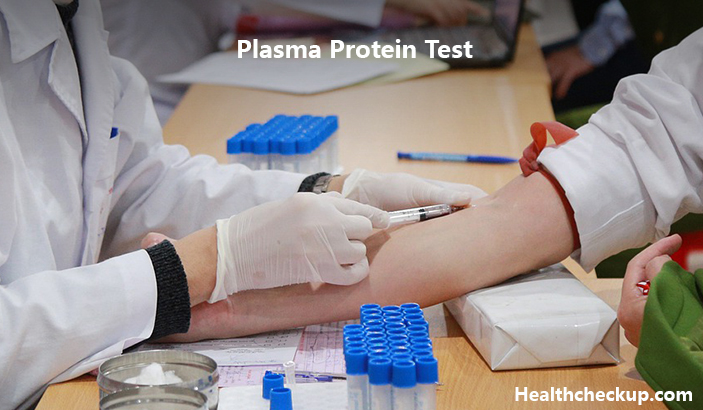Plasma protein is important for the normal functioning of the body. The altered level may cause complications. The doctor may recommend a plasma protein test for various diseases like inflammation or infection.
What Is A Plasma Protein Test?
The plasma protein test is also known as the total protein test. It measures the amount of total protein in the blood. The doctor may order this test as a part of the routine test. You may also undergo this test if the doctor identifies symptoms that could be due to altered blood protein levels.
Protein in the blood has various functions. It regulates metabolic activities and acts as a carrier for several medications. Alteration in their levels may indicate a primary problem, i.e., specific pathology, or secondary, i.e., secondary effect of various diseases.
Types Of Plasma Protein
There are two main types of proteins in plasma. These are;
1. Albumin
The normal level of serum albumin is 3.5 to 5.0 g/dl. The liver synthesizes albumin and is dissolved in the plasma. It helps in maintaining the oncotic pressure and manage fluid distribution. Alteration in the levels of albumin may result in fluid leakage. It also acts as a carrier for thyroid hormones, steroids, and fatty acids.
2. Globulin
The normal level of serum globulin is 2.6 to 3.5 g/dl. Types of globulins are alpha, beta, and gamma globulins. They are critical for blood clotting and promoting immunity. They also play a main role in liver function.
Why Is The Plasma Protein Test Done?
The doctor may recommend the plasma protein test in case of the following conditions;
- For diagnosing autoimmune disease or inflammatory condition
- Diagnosing bone marrow diseases such as cancer
- Hepatitis and HIV infection
- Peripheral edema
- Inflammatory bowel disease or kidney disease
- Liver dysfunction
- Malnutrition
- Allergic reaction
- Recurrent infections
Symptoms Of Abnormal Plasma Protein Levels
Patients may experience different symptoms due to high or low protein levels.
Symptoms Of High Protein Levels
- Pain in the bones
- Numbness and tingling sensation in peripheral organs such as legs and hands
- Excessive thirst
- Unexplained weight loss
- Recurrent infections
- Dehydration
Symptoms Of Protein Levels
- Delayed clotting after an injury
- Rashes and bruising on the skin
- Headache along with nausea and vomiting
- Persistent fatigue
- Brittle nails and loss of hairs
Causes Of Abnormal Plasma Protein Levels
There are various causes of abnormal plasma protein levels. These are;
- Protein loss due to nephrotic syndrome
- Dehydration and malnutrition
- Chronic inflammatory conditions such as Systemic Lupus Erythematosus or rheumatoid arthritis
- Protein malabsorption as seen in Crohn’s disease
- Acute infections such as hepatitis
- Bone marrow disease, including multiple myeloma
- Chronic liver disease, including liver cirrhosis
- Excessive protein loss through gut or skin
- Waldenström macroglobulinemia
How To Prepare For The Test?
The doctor may write the protein test on a prescription. You should immediately undergo the test. The doctor’s clinic may also have the facility for measuring the level of protein in the blood. There is no strict instruction to prepare for this test. Inform the doctor about the medications you are taking, as they may interfere with the results. These medicines include estrogen and birth control pills.
How Is The Test Done?
The expert phlebotomist will draw the blood as a sample. He will first wipe the area with the antiseptic. The phlebotomist then wraps a band on the arm. He then inserts the needle inside the vein at the back of your hand. Once the syringe is filled with the required quantity, the phlebotomist removes the needle and collects it in a bottle. He will give you cotton soaked in antiseptic to apply on the puncture site.
Plasma Protein Test Results
The total protein level in a healthy individual is 6 to 8.3 g/dl. The protein level depends upon various factors, including age, gender, and the method of testing.
A high level of protein indicates bone marrow diseases such as multiple myeloma. It may also be due to acute infections and chronic inflammatory conditions.
A low protein level indicates malnutrition, liver disease, excessive protein loss due to kidney disease, and extensive burns. A Low A/G ratio indicates autoimmune disorders and kidney or liver disease.
Conclusion
Altered protein levels may indicate several diseases. A high level may be due to inflammation or bone marrow diseases. Low protein levels may be due to kidney or liver disease or malnutrition.

Rohit Jain is an IPR Specialist and Medical Content Writing Expert. For over a decade, he has written several articles in the areas of female infertility, Erectile dysfunction, hemangioma, cervical cancer, monoclonal gammopathy of undetermined significance, mononucleosis, mitral valve disorder, nerve sheath tumor, shin splints, mild cognitive impairment, cellulitis, brain metastases, atelectasis, MCAD deficiency, lymphoma, sepsis, cardiac rehabilitation and metabolic disorder among others.









